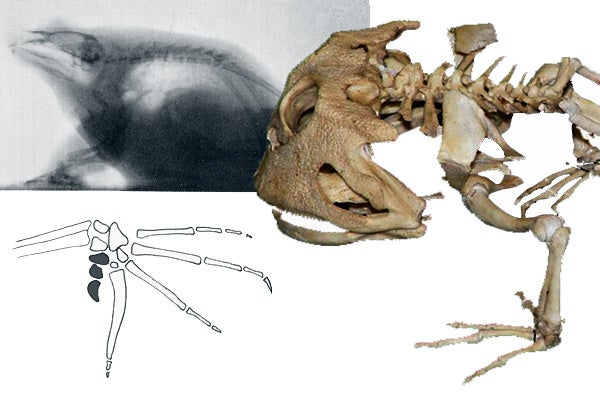
“The ability to jump at a wide range of angles is probably very important to this species as they hunt insects in trees at night and need to be able to move around in a complex, 3D environment,” said Porro.Įxperiments showed that, despite being able to move in a number of different ways, the African frog’s jumping performance was similar to that of other species that specialised in leaping. The arm bones of the human consist of the humerus, the radius and the ulna.

The collarbone of the bird is fused for stability and is called the furculum. Starting with amphibians, vertebrates typically have 4 limbs. For instance, the bones of a bird are hollow which makes the skeleton lighter. ray fin - tendency to lose proximal components of fin skeleton (see diagram below) Limbs. The knee joint appeared to be crucial in positioning the leg and determining the final take-off angle. The main difference between the human and bird skeleton is that the birds skeleton is adapted for flight. They inhabit a wide variety of habitats, with most species living within terrestrial, fossorial, arboreal or freshwater aquatic ecosystems. Sophisticated computer simulations showed the 3D motions of frogs’ legs are “astonishingly” complex, the researchers said.įorward power was primarily derived from the hip joint, while most of the vertical lift was driven by the ankle, the team found. All living amphibians belong to the group Lissamphibia. “Their capacity to jump at such a wide range of angles and distances is amazing.” On the whole, their organ structure is similar, but frogs have considerably less complex anatomies.
#Skeleton system of frog full
Males and females of each species have testes and ovaries respectively. This 4D Vision Full Skeleton Frog Model contains 17 fully detachable organs and body parts and features a transparent body to show internal structures. Looking at how a Frogs bone structure is made up and what bones contribute to everyday life. In other trials, the frogs rocketed upwards almost vertically,” said lead researcher Laura Porro. Both have lungs, kidneys, a stomach, a heart, a brain, a liver, a spleen, a small intestine and a large intestine, a pancreas, a gall bladder, a urinary bladder and a ureter. OpenStax Skills to Develop Discuss the different types of skeletal systems Explain the role of the human skeletal system Compare and contrast different skeletal systems A skeletal system is necessary to support the body, protect internal organs, and allow for the movement of an organism.


During jumping, muscles generated maximum power. The length changes and activation pattern that muscles undergo during jumping were measured, and isolated muscle bundles were driven through this in vivo pattern. “Some jumps were nearly horizontal, with animals skimming over the ground. The muscular system of frogs that jump is presumably designed to deliver these high powers.


 0 kommentar(er)
0 kommentar(er)
